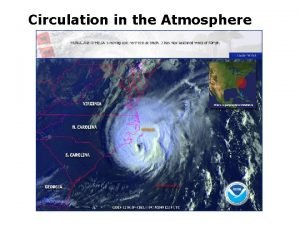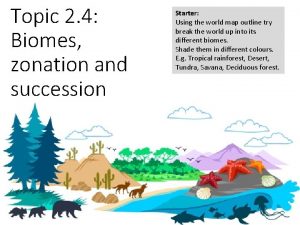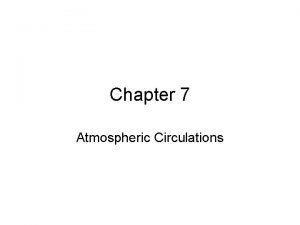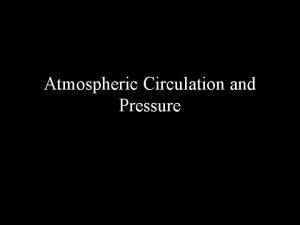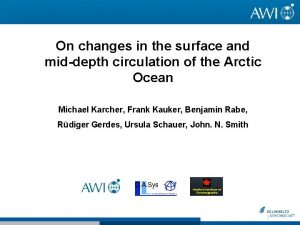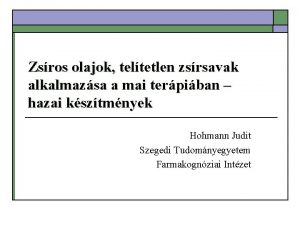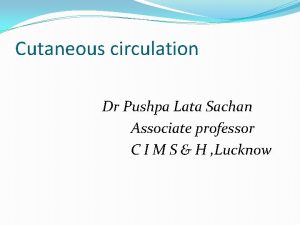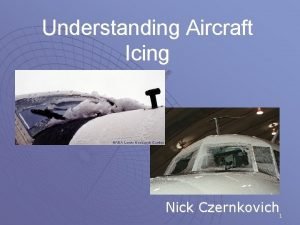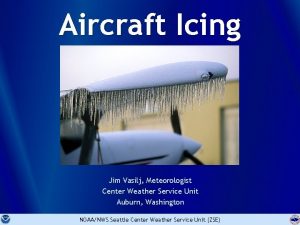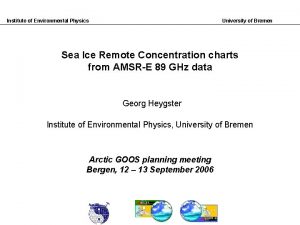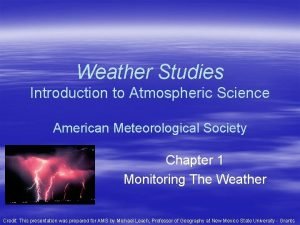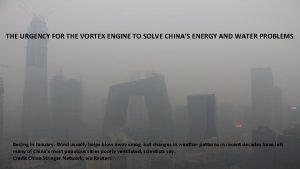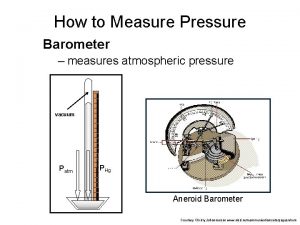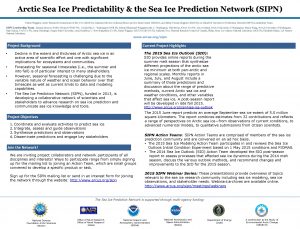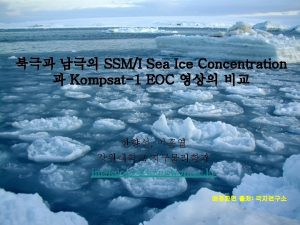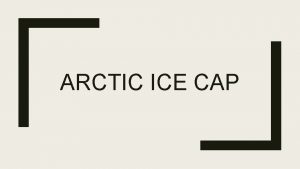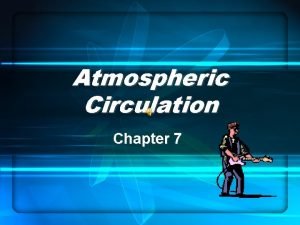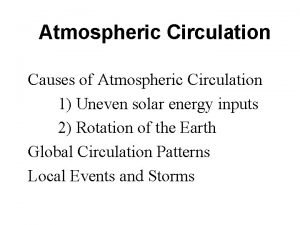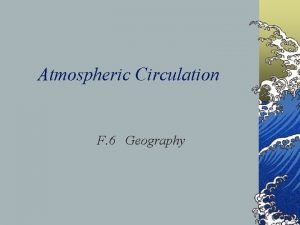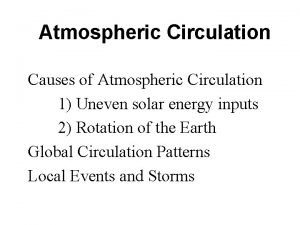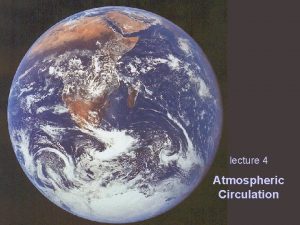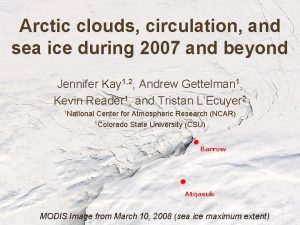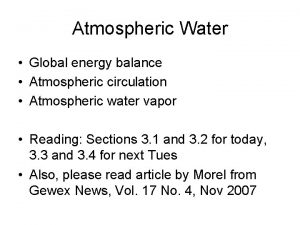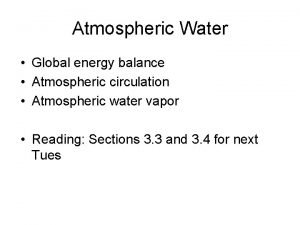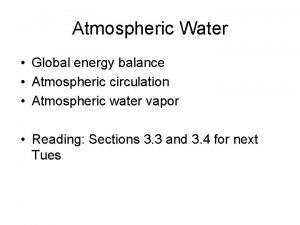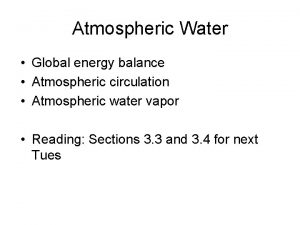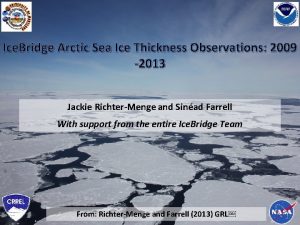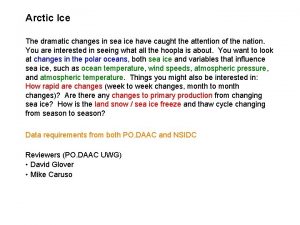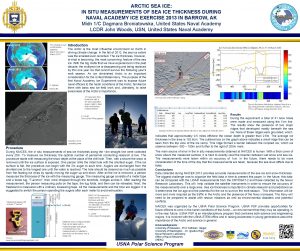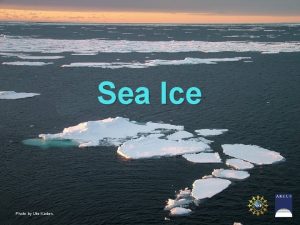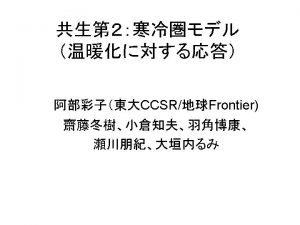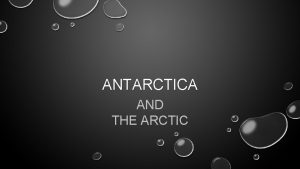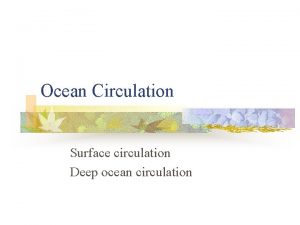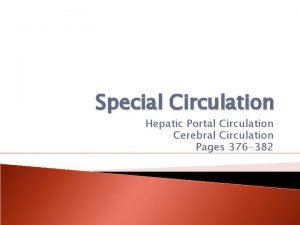Atmospheric Circulation Response to Future Arctic Sea Ice




























- Slides: 28

Atmospheric Circulation Response to Future Arctic Sea Ice Loss Clara Deser, Michael Alexander and Robert Tomas

Future Arctic Sea Ice Loss NCAR Coupled Model Simulation Ice Extent (106 km 2) Holland et al. (2006) September Sea Ice Extent Model drop 1. 8 million sq km, 2024– 2025 Observed drop 1. 6 million sq km, 2006– 2007 NCAR CCSM 3 model simulation Observations Figure courtesy of Julienne Stroeve

Future Arctic Sea Ice Loss NCAR Coupled Model Simulation Ice Extent (106 km 2) Holland et al. (2006) September Sea Ice Extent Model drop 1. 8 million sq km, 2024– 2025 Observed drop 1. 6 million sq km, 2006– 2007 NCAR CCSM 3 model simulation Observations 1980 -99 Figure courtesy of Julienne Stroeve 2080 -99 ~ 2 x. CO 2

CCSM 3 Arctic Sea Ice Concentration 1980 -99 2080 -99 (A 1 B) (%) September March

Approach Prescribe sea ice cover for 1980 -99 and 2080 -99 to Community Atmospheric Model Version 3 T 85 (1. 4° latitude x 1. 4° longitude); 26 levels DETAILS 60 year integrations with repeating seasonal cycle of time-average sea ice concentration and thickness: • 1980 -99 (CCSM 3 historical) • 2080 -99 (CCSM 3 A 1 B) • SSTs fixed at 1980 -99 values, set to -1. 8 C where sea ice removed and

Sea Ice Change: 2080 -99 minus 1980 -99 Sea Ice (%) Ice loss p_12 months_ice_pres_fut. gif Ice gain

Sea Ice Change: 2080 -99 minus 1980 -99 Sea Ice (%) Ice loss p_12 months_ice_pres_fut. gif Ice gain

Surface Energy Flux Response (Wm-2) Sea Ice Energy Flux p_12 months_ice_pres_fut. gif Positive upward

Air Temperature Response (°C) Sea Ice Air T 15 -20°C Sea Ice Air T p_12 months_ice_pres_fut. gif

Air Temperature Response (°C): Land Only Sea Ice Air T 2 -5°C Sea Ice Air T p_12 months_ice_pres_fut. gif

Snow Depth Response (cm liquid water equivalent) Air T Snow p_12 months_ice_pres_fut. gif

Sea Level Pressure Response (h. Pa) ci=1 h. Pa Sea Ice SLP shading = 95% significant Sea Ice SLP p_12 months_ice_pres_fut. gif

Sea Level Pressure Response (h. Pa) ci=1 h. Pa Sea Ice SLP shading = significant Sea Ice SLP p_12 months_ice_pres_fut. gif

How does the atmospheric circulation response to Arctic sea ice loss compare with the response to doubled CO 2 in the fully coupled CCSM 3?

Sea Level Pressure Response (h. Pa) ci=1 h. Pa CAM 3 CCSM 3 p_12 months_slp_ccsm 3_cam. gif

Sea Level Pressure Response (h. Pa) ci=1 h. Pa Atm Model Coupled Model p_12 months_slp_ccsm 3_cam. gif

SUMMARY Atmospheric Circulation Response to Future Arctic Sea Ice Loss • Largest sea ice loss in summer-fall (July-Nov), but largest surface energy flux response (which forces the atmosphere) in fall-winter (Oct-Mar) • Thermodynamic response: warming (and moistening) of the boundary layer especially in fall-winter (2 -5 K over land 15 -20 K over the Arctic ocean); increased snow cover Siberia and northern Alaska • Dynamic response: SLP response largest in fall-winter when it accounts for some of the response to 2 x. CO 2 in the coupled model; negligible in summer

Next Steps Atmospheric Circulation Response to Future Arctic Sea Ice Loss • Allow sea surface temperatures to respond to sea ice loss • Similar experiments with a regional high resolution atmospheric model (Cassano et al. ) and an AGCM with a resolved stratosphere • Similar experiments for snow cover (Tomas et al. )

Thank You

Extra Slides

Precipitation Response (mm day-1) Sea Ice Precip & SLP p_12 months_ice_slp_precp. gif

p_12 months_z 500 mb_1000 mb. gif

p_12 months_ice_cldtot. gif

Sea Ice Concentration (%) 1980 -99 2080 -99 p_12 months_ice_pres_fut. gif

Summer 2007 Arctic Sea Ice Loss September 2007 sea ice (white area) vs. September long term mean (pink line)

2080 -99 minus 1980 -99 Surface Energy Flux (Wm-2) SLP (h. Pa) Ci = 1 h. Pa; Shading sig p_12 months_ice_pres_fut. gif

p_t_profile_contour. gif

Surface Energy Flux Response (Wm-2) Radiative (LW) Turbulent (SH+LH) p_12 months_ice_pres_fut. gif
 Atmospheric circulation
Atmospheric circulation S shape curve
S shape curve Single cell model of atmospheric circulation
Single cell model of atmospheric circulation Single cell model of atmospheric circulation
Single cell model of atmospheric circulation Arctic circulation
Arctic circulation Single circulation and double circulation
Single circulation and double circulation Bronchioles
Bronchioles Single circulation and double circulation
Single circulation and double circulation Eskimo 3 halolaj
Eskimo 3 halolaj Arctic sea omega 3 faydaları
Arctic sea omega 3 faydaları Exercise future continuous and future perfect
Exercise future continuous and future perfect Future perfect e future continuous
Future perfect e future continuous Triple response and cutaneous circulation
Triple response and cutaneous circulation Nick czernkovich
Nick czernkovich Clear ice vs rime ice
Clear ice vs rime ice Ice sea blue
Ice sea blue University of bremen sea ice
University of bremen sea ice Sea cave
Sea cave Yellow sea and east china sea
Yellow sea and east china sea Sea anemone jellyfish
Sea anemone jellyfish Marlin symbolism
Marlin symbolism Aegean sea troy
Aegean sea troy Natural response and forced response
Natural response and forced response Natural and forced response
Natural and forced response A subsequent
A subsequent Atmospheric physics lecture notes
Atmospheric physics lecture notes American meteorological society
American meteorological society Atmospheric vortex engine
Atmospheric vortex engine It measures atmospheric pressure
It measures atmospheric pressure
